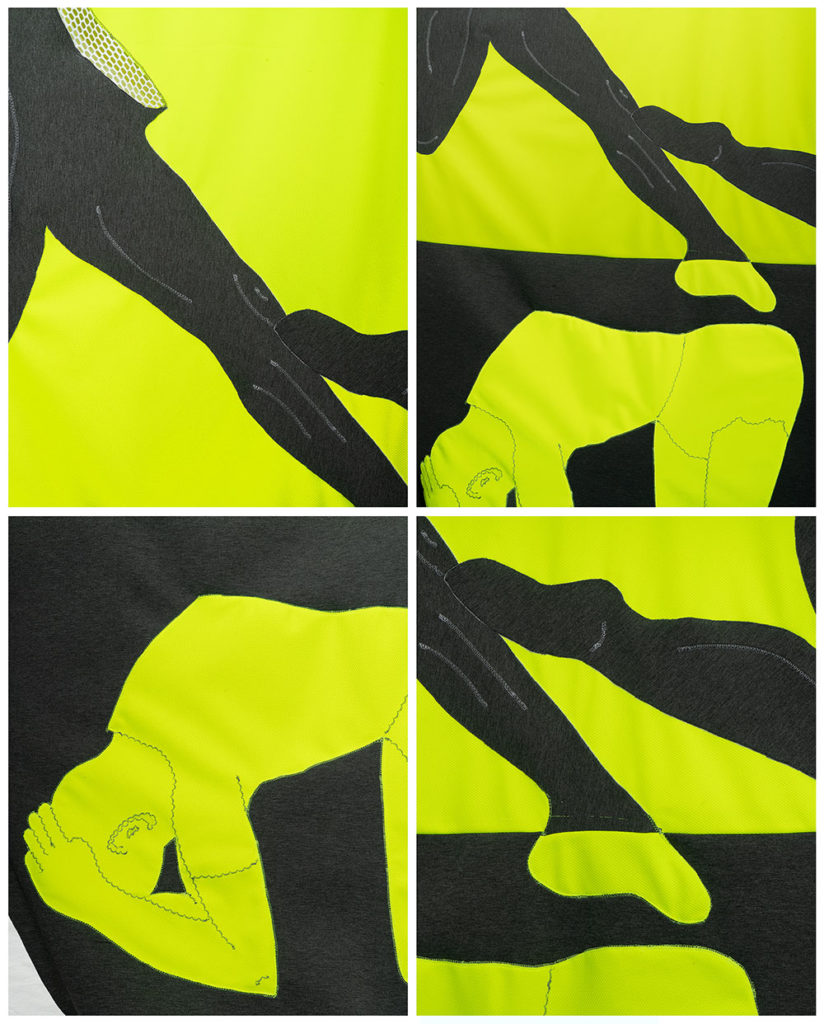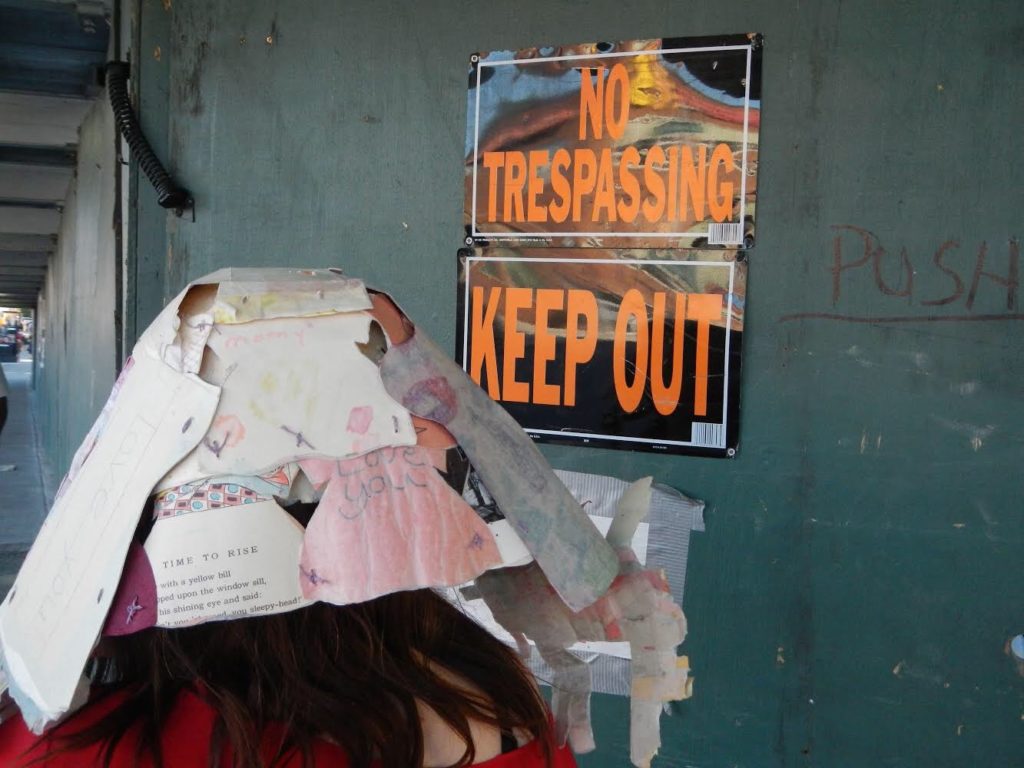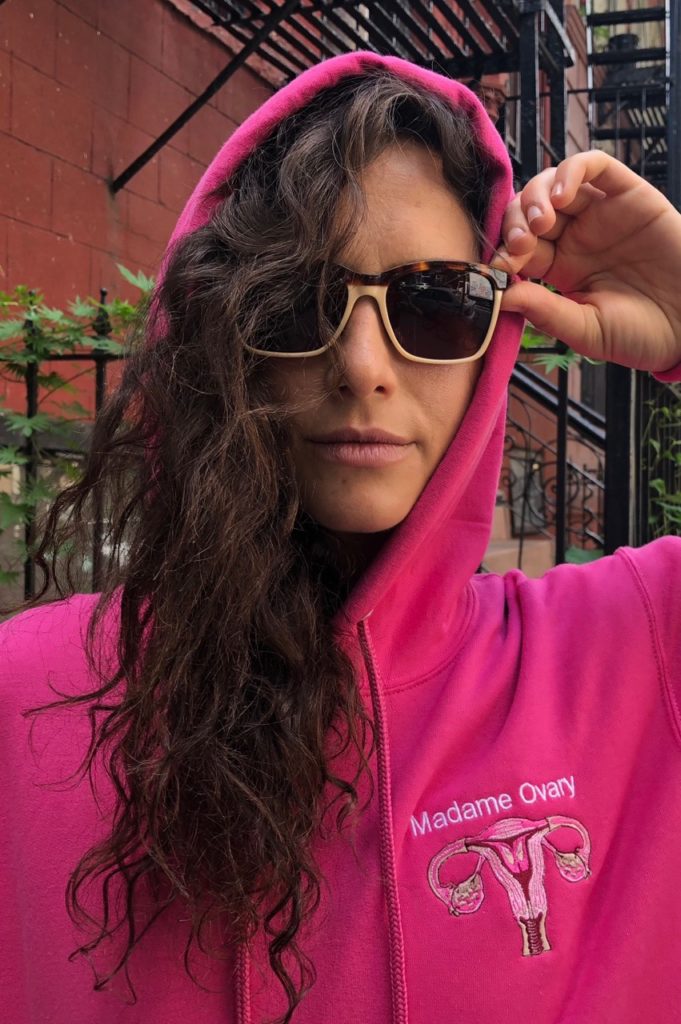Each week we feature artists from Art in Odd Places 2018: BODY NYC.

Rose Nestler, Gymnasia Hysteria Details of Amphora, 2018, Photo Credit: Kim Hoeckele
Rose Nestler
1. Tell us about yourself and your project for AiOP BODY 2018:
Rose Nestler is a NY based interdisciplinary artist focusing in sculpture and video.
The central object of this project is a giant soft vessel made out of fabric commonly used for athletic wear. It is modeled after Greek Amphorae given to athletes as reward for winning sporting events in the Panathenaic games.
Through video, sculpture and performance, Gymnasia Hysteria presents an investigation into the correlation between athleticism, spirituality and patriarchy. Drawing its aesthetic inspiration from the ancient Greco-Roman gymnasia, this work illustrates sports, ceremonies and rewards that sustain the oppressive regime of masculinity within American culture. Although sports culture can stem from and breed toxic masculinity, exercise and team sports, are capable of moving beyond gender, fostering experiences where those who are objectified can achieve momentary transcendence.
2. What does the theme BODY mean to you?
As a child, I went through open heart surgery. One of my first memories involved lying on a bench and “stitching” my own body up with string. I noticed that this early memory was informing my practice. The point of departure for my artistic interests are the delicacy and imperfections of bodies.

Daniela Kostova (in collaboration with Miryana Todorova), Monuments of Incomplete Transition, 2010. Photo Credit: Steve deSeve.
Daniela Kostova
1. Tell us about yourself and your project for AiOP BODY 2018:
I am an interdisciplinary artist, interested in hybrid cultures and architecture that emerge from conditions of global change and migrations. My personal narrative and background informs all of my work. It engages specific sites and communities, and often include participatory elements.
At AiOP I am presenting Monuments of incomplete Transition, conceived in 2010 in collaboration with Miryana Todorova and performed on the streets of NYC. It involves eight large-format vinyl prints (based on photographs of building structures from Bulgaria) that take the form of mobile booths when put together. The printed, full-scale images of these structures are mounted on poles and so could be easily taken down and put up again referencing nomadic practices.
2. What does the theme BODY mean to you?
MIT represents bodies/spaces in transition and a type of architecture, which would be impossible without cooperation. The temporary structures form shared space that is intended for and supported by bodies. Foreign bodies themselves that are extension of my own body, both concealing and revealing.

Kat Cope, I love you. You love me: helmet, 2016. Photo Credit: David Chosid
DON’T MOVE: Kat Cope, Kelly Savage, Kate Frazer Rego
1. Tell us about yourself and your project for AiOP BODY 2018:
The title of our piece, Don’t Move, inherently lends itself to our bodies disrupting NYC’s pedestrian flow. There are these unspoken rules of patterned movement throughout the city riddled with micro-aggressions where women are lower on the hierarchical claim to space, often moving out of the way of men to give way. With Don’t Move, we claim space as well as demand our bodies be both a spectacle and a physical presence that requires deeper consideration.
2. What does the theme BODY mean to you?
The word body often evokes the image of a human but it also refers to a collection. NYC feels like a body in of itself; a metaphorical conglomerate of nerves, tissue and flesh constantly morphing and moving while remaining a still island.

Jody Oberfelder Projects, Madame Ovary, 2018. Photo Credit: Jody Oberfelder. Pictured: Maya Orchin
Jody Oberfelder
1. Tell us about yourself and your project for AiOP BODY 2018:
Madame Ovary is a performance for an audience of one, a place to contemplate how one’s body is a site for agency, intuition, and birth. How has this region that defines a woman and produces life also be construed as a limiting space, reducing gender identity to genitalia? Oberfelder’s film “Duet” made when she was 8 months pregnant will be displayed in the Westbeth gallery, accompanied by index cards with specific body related questions, charting the viewer’s response.
2. What does the theme BODY mean to you?
As a dancer, as a mother, as a woman, as a human being, the body is everything. The body is also an encasement that defines the way we function in the world, how we are perceived, how we travel, how we make imprints in history.

Legacy Fatale, Unbound Feminisms and Territorialities, 2016. Photo credit: Ivy Blackshire
LEGACY FATALE
1. Tell us about yourself and your project for AiOP BODY 2018:
Legacy Fatale is an on-going project celebrating female empowerment through our performance art collective and interdisciplinary social practices. For AiOP/BODY, director Coco Dolle has chosen to cross-over the world of punk with the politics of resistance. In spirit of the Suffragettes movement, we present ‘Tug of War at Beauty Bar.’ Beauty Bar is one of the last remaining staples of East Village culture resisting gentrification. Legacy Fatale invites the audience to a choreographed protest/war game happening outside the Beauty Bar, that will move indoors to an abstract performance, a signature movement of Legacy Fatale, followed by a musical act: ‘What Would Tilda Swinton Do.’
2. What does the theme BODY mean to you?
BODY is a territory for activating social awareness and changing paradigms.

Luiza Kurzyna, Kiss My Face, 2018. Photo credit: Alex Buly
Luiza Kurzyna
1. Tell us about yourself and your project for AiOP BODY 2018:
I approach creating art as a form of therapy and play. I like to observe my surroundings and complex relationships within it. These visual memories of the natural world mix with a self reflective process from which I create objects to be played or performed with. These often become wearable costumes or puppets with a specific function that’s driven by a desire or critical impulse. In the case of You Are What You Eat, I intend to alter how my body is perceived publicly, by donning a bodysuit with exaggerated breasts resembling sausages, stuffed with “consumables.” To me, the project is a humorous and critical reflection of what I’ve felt like in the recent political/societal landscape and the emotional toll by what we consume on a regular basis, not just through food but also through the news, sexism, and consumer culture. Through the context of playful absurdity and vulnerability, I hope to bring the intimate and personal into the public space.
2. What does the theme BODY mean to you?
The Body is contradictory. It’s full of other bodies and yet one’s own. It’s defined separately from the mind or spirit and yet it’s equated to the full being. Depending on perspectives and prejudices, the external can be beautiful or grotesque. It affects how we live, function and coexist.

x senn-yuen rance, Dissociation Station in Need of Translation, 2018. Photo Credit: Monika Rostvold
x senn-yuen rance
1. Tell us about yourself and your project for AiOP BODY 2018:
x senn-yuen rance is a queer, trans artist of color from Miami, Florida. Their interdisciplinary works engage with mental health, trauma, gender identity, and their hypersexualized and racialized body. “The Cleanse” is an ongoing life/art project that includes mania, depression, hospitalization, documentation, and recovery. “The Cleanse” is a performance; “The Cleanse” is their life. This is the journey and continuation of the artist’s detox from colonization and the white supremacy that has dictated, controlled, manipulated, and infected their mind, body, and spirit. This iteration of “The Cleanse” explores the perceptions, assumptions, and impositions of/on the artist’s body; blurring the lines of what is expected and what is natural.
2. What does the theme BODY mean to you?
body means vessel. as an interdisciplinary performance artist and dancer of multi-marginalized identity, my body is always being used, shamed, or manipulated. in my work, i think of my body as the ultimate vessel in an attempt to salvage and reclaim the bits of me that are authentic and true.

Treizman/Brazil, Off the Grid-iron (Prototypes), 2018. Photo Credit: Adam Brazil
Denise Treizman and Adam Brazil
1. Tell us about yourself and your project for AiOP BODY 2018:
“Off the Grid-iron” is a collaborative project between artists Denise Treizman and Adam Brazil. Denise Treizman is an artist from Chile, currently based in New York. Her sculpture and installation repurposes found and ready-made objects, combined with clay and fiber elements. Her process embraces chance, explores material and spatial relationships and relies on resourcefulness. Adam Brazil is an interdisciplinary artist and professor at Syracuse University. His work approaches social issues with dark humor and material experimentation. He is currently preparing works for his first solo exhibition in NYC at MEN gallery in the Lower East Side.
2. What does the theme BODY mean to you?
Our project comments on notions of gender, exclusivity and the body. Vibrantly glazed footballs function as vessels of energy to be passed down the street until they reach the end zone, where a performer will smash them, shattering preconceived interpretations of sport.

